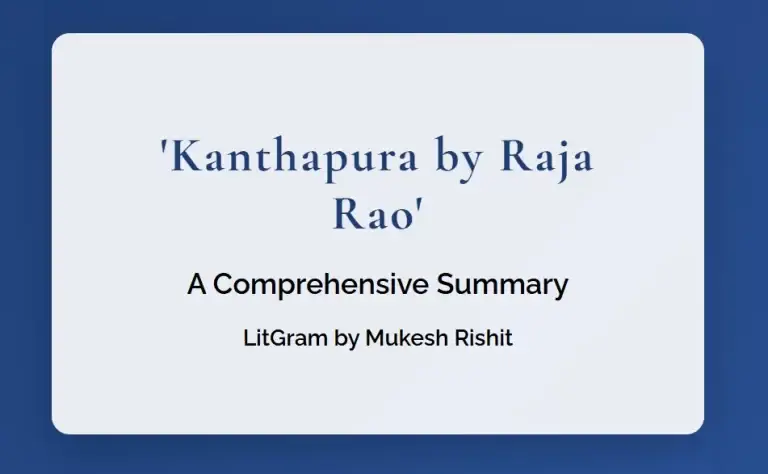Kanthapura Summary– The year 1938 marked a pivotal moment in Indian literature when Raja Rao’s Kanthapura emerged as a powerful chronicle of India’s freedom struggle. Through the lens of a small South Indian village, this revolutionary novel captures the profound impact of Mahatma Gandhi’s teachings on rural India during the independence movement.
While most historical accounts focus on urban centers, Kanthapura tells its story through the voice of an elder village woman, Achakka, who narrates the tale in the style of a traditional Indian purana. The narrative follows the village’s remarkable transformation from a peaceful settlement bound by strict caste systems to a center of political activism and non-violent resistance against British rule.
This comprehensive guide explores how the novel portrays the villagers’ journey through the independence movement, the emergence of local leaders like Moorthy, and the significant role of women in the struggle. Readers will discover how this masterpiece captures the essence of Gandhian principles, the price of resistance, and the ultimate sacrifice of a village that dared to challenge colonial authority.
Kanthapura Summary
Raja Rao, one of India’s pioneering English novelists, crafted Kanthapura between 1929 and 1938 in Chennai. The novel emerged at a crucial period in India’s struggle for independence, specifically chronicling the events from 1919 to 1931.
Historical context of the novel
The narrative unfolds against the backdrop of Gandhi’s non-violent resistance movement. Subsequently, the story mirrors the nationwide response to significant events, including the historic Dandi March and the breaking of the Salt Law. Furthermore, the novel portrays the social reforms of the era, addressing issues such as untouchability, child marriage, and economic exploitation under British rule.
Significance in Indian literature
Kanthapura stands as a distinguished work in Indo-Anglican literature, reflecting the deepest urges and problems of Indian life. Raja Rao’s contribution to Indian English literature proves significant as he successfully conveyed Indian thoughts, feelings, and cultural ideology in English. Additionally, the novel serves as both a literary masterpiece and a historical document, capturing the essence of India’s freedom struggle through the microcosm of a village.
Narrative style and structure
The novel’s most distinctive feature lies in its narrative technique, employing the ancient Puranic method of storytelling. Through Achakka, an elderly village woman, the story unfolds in the traditional oral narrative style. The narrative flows chronologically, yet incorporates various elements:
- Religious ceremonies and festivals
- Folk tales and local legends
- Traditional storytelling patterns
- Blend of myth and reality
The narrative structure deliberately modifies English syntax to match Indian emotional expressions. Moreover, Raja Rao achieves authenticity by incorporating Indian imagery, proverbs, and idioms throughout the text. Consequently, the novel succeeds in capturing the tempo of Indian life while using a foreign language.
The Heart of Freedom Struggle in Kanthapura
The small village of Kanthapura became a microcosm of India’s freedom struggle through its remarkable embrace of Gandhian principles.
Gandhian influence on village life
Moorthy, a young Brahmin educated in the city, emerged as the village’s spiritual and political guide. Rather than merely preaching Gandhi’s philosophy, he actively demonstrated it through regular charkha spinning and organizing bhajans. Notably, the village witnessed a profound transformation as Moorthy introduced innovative methods like Harikatha to spread nationalist ideals.
Non-violent resistance movement
The village’s resistance movement gained momentum through several coordinated actions:
- Organizing Satyagraha outside toddy plantations
- Implementing no-tax campaigns against British authorities
- Conducting peaceful protests at Skeffington Coffee Estate
- Distributing free publicity material and forming volunteer corps
Nevertheless, the peaceful protesters faced severe repression. The police responded with lathi charges, and many villagers, including women and children, suffered injuries. Primarily, the movement’s strength lay in its unwavering commitment to non-violence, even in the face of brutal opposition.
Social transformation and unity
The freedom struggle essentially catalyzed unprecedented social changes in Kanthapura. Indeed, the village’s transformation extended beyond political resistance to challenge deep-rooted social structures. The movement brought together people across caste lines, with Moorthy himself breaking traditional barriers by visiting untouchable quarters. Women, led by characters like Ratna and Rangamma, stepped forward to maintain the resistance during Moorthy’s imprisonment, marking a significant shift in gender roles.
Character Analysis and Symbolism
Characters in Kanthapura embody profound symbolic significance that extends beyond their individual roles.
Moorthy as Gandhi’s representative
Moorthy emerges as a powerful symbol of Gandhian ideology in the novel. After experiencing a transformative vision of Gandhi addressing a public gathering, he abandons his college education to become the village’s spiritual guide. His actions mirror Gandhi’s principles as he throws his foreign clothes and books into fire. Primarily, Moorthy’s greatest symbolic act manifests in breaking caste barriers by entering a Pariah’s house, although “the room seems to shake and all the gods and all the manes of heaven seem to cry out against him”.
Women warriors of Kanthapura
The formation of ‘Sevika Sangho’ symbolizes Durga or Shakti, the destroyer of demons. Accordingly, Rangamma leads this transformation by publishing political pamphlets and organizing daily discussions on nationalist movements. Although widowed at fifteen, Ratna breaks traditional constraints, refusing to accept womanhood as a mark of shame or inferiority.
Religious and cultural symbolism
The novel interweaves rich layers of religious and cultural symbolism:
- The Skeffington Coffee Estate represents European industrialization’s impact on Indian life, with the red-men symbolizing British violence
- Gandhi emerges as Prince Rama resisting the demonic rule of Ravana, the ‘Red-men’
- The temple serves as both a spiritual center and a site of resistance, becoming a focal point for community gatherings
- The mango tree stands as a symbol of sustenance and connection to ancestral heritage
Hence, through these symbolic elements, Raja Rao crafts a narrative that connects individual struggles with larger themes of nationalism and cultural identity.
Impact and Legacy of Kanthapura
Published in 1938, Kanthapura created a distinct shift in Indian English literature through its groundbreaking narrative approach and cultural authenticity.
Literary influence on Indian writing
Raja Rao pioneered a unique style of Indian English writing by masterfully blending Western novel techniques with traditional Indian storytelling methods. His innovative approach included:
- Creating an Indian variety of English with flexibility and elegance
- Incorporating local festivals and cultural expressions
- Adapting traditional oral narrative techniques
- Developing a distinctive “Kannadized” English dialect
Historical documentation value
Primarily serving as both literature and historical record, Kanthapura captures the uncertainty and complexity of the Indian Independence Movement. The novel documents the social transformation of rural India, particularly focusing on the evolution of characters who defend their community against colonial oppression. Therefore, its value extends beyond mere storytelling, offering authentic insights into the period’s social and political dynamics.
Modern day relevance
The themes explored in Kanthapura continue to resonate with contemporary readers. The novel’s examination of colonialism, social justice, and community resistance remains pertinent to modern discussions about decolonization. Similarly, its portrayal of women breaking traditional gender roles and the dismantling of caste barriers speaks to ongoing struggles for equality. Overall, the novel’s depiction of collective resistance against oppression particularly reflects current social movements and the continuing fight for justice.
Conclusion
Raja Rao’s Kanthapura stands as a masterpiece that transcends traditional storytelling boundaries. Through its innovative narrative style and authentic portrayal of village life, the novel captures the essence of India’s freedom struggle from a unique perspective. Above all, the story demonstrates how Gandhian principles transformed a small village into a powerful symbol of resistance against colonial rule.
The novel’s depiction of social transformation certainly resonates with modern readers. Characters like Moorthy, Rangamma, and Ratna represent timeless ideals of courage, sacrifice, and unity. Their journey from traditional village life to active resistance mirrors countless struggles for justice worldwide.
Kanthapura’s literary significance extends beyond its historical context. The seamless blend of Indian storytelling traditions with English narrative techniques created a new path for Indian English literature. Therefore, Raja Rao’s work serves both as a cultural bridge and a testament to India’s rich literary heritage.
The story of Kanthapura ultimately reminds readers that great social changes often begin in small communities. Through its vivid portrayal of village life, caste dynamics, and gender roles, the novel continues to offer valuable insights into the power of collective action and non-violent resistance.
FAQs
Q1. What is the central theme of Kanthapura regarding India’s freedom struggle? Kanthapura explores the impact of Gandhian principles on a small South Indian village during the independence movement. It highlights themes of non-violent resistance, social transformation, and unity across caste and gender lines in the fight against British colonial rule.
Q2. How does the novel portray Moorthy as a Gandhian leader? Moorthy embodies Gandhian ideals by practicing non-violence, promoting truth and moral integrity, and encouraging villagers to participate in civil disobedience. He introduces innovative methods like charkha spinning and bhajans to spread nationalist ideals and breaks caste barriers by entering untouchable quarters.
Q3. In what ways does Kanthapura represent a microcosm of India during the freedom struggle? The village of Kanthapura serves as a miniature representation of India, showcasing how traditional cultural systems, reinvigorated by Gandhian ideology, create a sense of national belonging. The novel depicts the village’s transformation from a caste-bound settlement to a center of political activism, mirroring the larger Indian independence movement.
Q4. How does the novel portray women’s roles in the freedom struggle? Kanthapura highlights the significant role of women in the independence movement. Characters like Ratna and Rangamma lead resistance efforts, organize protests, and maintain the movement during male leaders’ imprisonment. The formation of the ‘Sevika Sangho’ symbolizes women’s empowerment and their active participation in the struggle.
Q5. What makes Kanthapura’s narrative style unique in Indian English literature? Raja Rao employs a distinctive narrative technique in Kanthapura, blending the ancient Puranic method of storytelling with English prose. The novel is narrated by an elderly village woman, Achakka, in a traditional oral style. Rao adapts English syntax to match Indian emotional expressions and incorporates local imagery, proverbs, and idioms, creating an authentic representation of Indian life in English literature.



3 Comments
Pingback: The Serpent and the Rope: A Comprehensive Analysis and Study Guide
Pingback: A Comprehensive Look at The Chessmaster and His Moves by Raja Rao
Pingback: The Henna Artist by Alka Joshi: A Journey of Art, Culture, and Empowerment